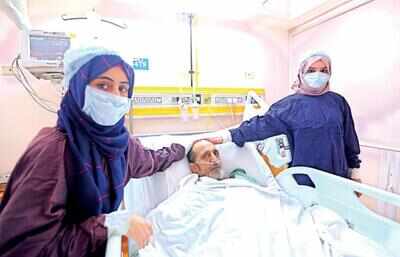
NEW DELHI: When Al Naqeeb, a Yemeni national suffering from end-stage liver disease, was told by doctors he needed a liver transplant, all three of his children offered to donate a part of their organ to save their father. As Naqeeb’s son was obese, he was ruled out as a potential donor.
So, on the family’s request, the doctors at Apollo Hospital then started investigating Naqeeb’s daughters — Bahaja and Sarah — for organ donation. For liver transplants in cases of living donors, a patient’s diseased liver is replaced with a partial healthy liver from another person.
In a typical adult recipient, 55% to 70% of the liver (the right lobe) is removed from a healthy living donor. The donor’s liver regenerates approaching 100% function within four to six weeks.
However, in this case, both daughters, who are in their 20s, had less than the required volume of liver. The doctors could not perform the transplant with either girl.
Since there were no other donors, the daughters insisted that doctors explore if they could both donate parts of their liver, which could be used together for the transplant. “Dual lobe liver transplant is possible, but it is more complex. Because we didn’t have any other option to save the patient’s life, we give it a chance and succeeded,” said Dr Goyal, senior consultant liver transplant at the hospital.
He explained that they took out thr right lobe of the Bahaja’s liver, weighing 400 grams, and the left lobe of Sarah’s liver that weighed 240 gm, and implanted both in the recipient.
“There was a lot of pressure on our team as two donors were involved in the process. The patient’s transplant was already a high-risk one due to his multiple problems. But we succeeded in giving the patient a new lease of life,” Dr Goyal said.
The transplant was carried on May 23, and the doctor said that Naqeeb is fit enough to be discharged from hospital now. “Bahaja and Sarah are doing well too,” he added.
Dual lobe liver transplants are rare because they are complex. In a single donor transplant, the venous channel in only side of the liver has to be connected in the recipient. But a dual lobe transplant, venous channels of both the right lobe and the left lobe have to be joined, the doctor explained.
So, on the family’s request, the doctors at Apollo Hospital then started investigating Naqeeb’s daughters — Bahaja and Sarah — for organ donation. For liver transplants in cases of living donors, a patient’s diseased liver is replaced with a partial healthy liver from another person.
In a typical adult recipient, 55% to 70% of the liver (the right lobe) is removed from a healthy living donor. The donor’s liver regenerates approaching 100% function within four to six weeks.
However, in this case, both daughters, who are in their 20s, had less than the required volume of liver. The doctors could not perform the transplant with either girl.
Since there were no other donors, the daughters insisted that doctors explore if they could both donate parts of their liver, which could be used together for the transplant. “Dual lobe liver transplant is possible, but it is more complex. Because we didn’t have any other option to save the patient’s life, we give it a chance and succeeded,” said Dr Goyal, senior consultant liver transplant at the hospital.
He explained that they took out thr right lobe of the Bahaja’s liver, weighing 400 grams, and the left lobe of Sarah’s liver that weighed 240 gm, and implanted both in the recipient.
“There was a lot of pressure on our team as two donors were involved in the process. The patient’s transplant was already a high-risk one due to his multiple problems. But we succeeded in giving the patient a new lease of life,” Dr Goyal said.
The transplant was carried on May 23, and the doctor said that Naqeeb is fit enough to be discharged from hospital now. “Bahaja and Sarah are doing well too,” he added.
Dual lobe liver transplants are rare because they are complex. In a single donor transplant, the venous channel in only side of the liver has to be connected in the recipient. But a dual lobe transplant, venous channels of both the right lobe and the left lobe have to be joined, the doctor explained.
World Cup 2019
Trending Topics
LATEST VIDEOS
City
 Bihar: Hundreds of skeletal remains found behind Sri Krishna Medical College and Hospital in Muzaffarpur
Bihar: Hundreds of skeletal remains found behind Sri Krishna Medical College and Hospital in Muzaffarpur  Depressed Delhi tutor slits throats of 3 kids, wife
Depressed Delhi tutor slits throats of 3 kids, wife  Bengaluru airport: 7 passengers walk in without undergoing security checks
Bengaluru airport: 7 passengers walk in without undergoing security checks  Water crisis in Chennai: Political parties turning to pujas and yagnas
Water crisis in Chennai: Political parties turning to pujas and yagnas
More from TOI
Navbharat Times
Featured Today in Travel
Quick Links
Lok Sabha Election Schedule 2019Lok Sabha Election NewsDelhi Capitals teamMI team 2019Rajasthan Royals 2019RCB team 2019Maharashtra Lok Sabha ConstituenciesBJP Candidate ListBJP List 2019 TamilnaduShiv Sena List 2019AP BJP List 2019Mamata BanerjeeBJP List 2019 MaharashtraPriyanka GandhiBJP List 2019 KarnatakaAMMK Candidate List 2019BJP List 2019 WBLok Sabha Elections in Tamil NaduBSP List 2019 UPNews in TamilLok Sabha Poll 2019Satta Matka 2018PM ModiMahagathbandhanNagpur BJP Candidate ListChandrababu NaiduTamil Nadu ElectionsUrmila MatondkarNews in TeluguMadras High CourtTejashwi YadavArvind KejriwalTejasvi SuryaPawan KalyanArvind KejriwalYogi AdityanathJaya PradaSatta King 2019Srinagar encounter
Get the app





